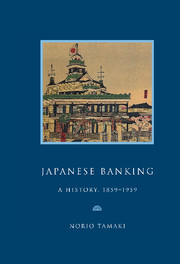Book contents
- Frontmatter
- Contents
- Preface
- Genealogy of leading Japanese banks, 1859–1959
- List of abbreviations
- Map
- Part I A bankrupt Shogunate, 1859–1868
- Part II The Meiji Restoration: monetary confusion and banking experiments, 1868–1881
- Part III Matsukata, the wizard of Japanese banking, 1881–1897; the Yokohama Specie Bank (1880) and the Bank of Japan (1882)
- Part IV The Japanese on the London money market, 1897–1911
- Part V War, the Japanese boom years, 1911–1919
- Part VI Crisis and the road to war, 1919–1937
- Part VII Complete commitment, struggle and defeat, 1937–1945
- Historical background
- 25 War budgets and the mobilisation of national resources, 1937–1943
- 26 Extraordinary banking business during the national emergency, 1941–1945
- 27 Crisis, 1945
- Part VIII American ‘democratisation’ and the search for growth, 1945–1959
- An extraordinary century, 1859–1959
- Appendices
- Notes
- Bibliography
- Index
27 - Crisis, 1945
Published online by Cambridge University Press: 03 February 2010
- Frontmatter
- Contents
- Preface
- Genealogy of leading Japanese banks, 1859–1959
- List of abbreviations
- Map
- Part I A bankrupt Shogunate, 1859–1868
- Part II The Meiji Restoration: monetary confusion and banking experiments, 1868–1881
- Part III Matsukata, the wizard of Japanese banking, 1881–1897; the Yokohama Specie Bank (1880) and the Bank of Japan (1882)
- Part IV The Japanese on the London money market, 1897–1911
- Part V War, the Japanese boom years, 1911–1919
- Part VI Crisis and the road to war, 1919–1937
- Part VII Complete commitment, struggle and defeat, 1937–1945
- Historical background
- 25 War budgets and the mobilisation of national resources, 1937–1943
- 26 Extraordinary banking business during the national emergency, 1941–1945
- 27 Crisis, 1945
- Part VIII American ‘democratisation’ and the search for growth, 1945–1959
- An extraordinary century, 1859–1959
- Appendices
- Notes
- Bibliography
- Index
Summary
Between the Marco Polo Bridge Incident of 1937 and the Japanese defeat in the Pacific War in August 1945, the total liabilities/assets of all the banks increased sevenfold to ¥188,600 million, those of trust companies, threefold to ¥6,700 million, insurance companies, fourfold to ¥14,700 million and post offices twelvefold to ¥47,200 million. Monetary assets of the main institutions, of which banking occupied nearly three-quarters, totalled ¥257,200 million, more than twelve times the national income in 1937 when the economy was put on to a war footing. However, their figures were deceptive: there was in fact a great deal of illiquidity. First, more than one-third of these assets were in national bonds. Second, lending was often of ‘dead loans’ locked up in munitions industries. In fact two-thirds of them proved to be unsecured by the end of 1943 when the Japanese forces were fighting the Americans desperately in south-eastern seas, losing one battle after another. Nobody could believe that the loans would be reimbursed.
What sustained such a large amount of national bond holdings of banks and other institutions and such a tremendous sum of unsecured advances to munitions industries was Bank of Japan notes. In 1937, the Bank of Japan notes outstanding were ¥2,305 million, of which ¥504 million were in excess of the fiduciary limit. The fiduciary limit was extended twice before 1940 to ¥2,200 million. The new Bank of Japan Act of 1942 allowed the Bank to abandon the concept of the fiduciary issue and gave the Bank outright control of the note issue. A limit was set at ¥6,000 million but the Minister of Finance was authorised to go beyond this if necessary.
- Type
- Chapter
- Information
- Japanese BankingA History, 1859–1959, pp. 180 - 182Publisher: Cambridge University PressPrint publication year: 1995



